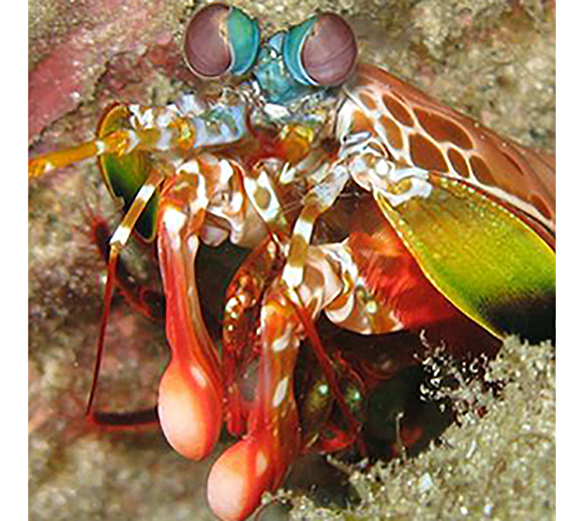Professor Swanson Co-Authors Study of Super Tough Crustacean

Gonzaga News Service
SPOKANE, Wash. — Gonzaga University biology Associate Professor Brook Swanson is part of a scientific team whose newly published research in the journal Science suggests lessons learned from studying the structure of the peacock mantis shrimp may help engineers design lighter, stronger materials for military, medical and other applications.
Harvard University scientist James Weaver and 10 colleagues, including Professor Swanson, used electron microscopy and other techniques to examine the critters' structure at nanoscopic scale to see how its hammer-like, bright orange legs, which are capable of smashing snails and even aquarium glass, survive even after being pounded and damaged by multiple blows. The multicolored crustaceans have excellent vision, remarkably resilient armor, and a lightning-fast punch that accelerates faster than a .22-caliber bullet. They use this capability to smash open tough-shelled prey and can do so up to 50,000 times between molts without destroying their clubs. The creature, known scientifically as a "stomatopod," can punch with impact more than 1,000 times its own weight.
The authors have discovered what makes these claws so tough. Their front legs have three regions, each containing different material compositions and mechanical properties. The striking face of their club is dense with hydroxyapatite, a mineral found in vertebrate bones and teeth. This hard, thin face is supported by a region with rods of the organic material chitosan, providing superior resistance to fracture. Any cracks that develop in the face of the claw must continually change directions, slowing their growth. Parts of a third, striated region along the sides of the claw are less stiff than the impact region. The transition between impact surface and the material underlying it helps deflect cracks, further preventing damage. The study's authors suggest the discovery could help material engineers develop lighter, tougher materials for objects designed to endure repetitive, intense impacts.
Professor Swanson, in Gonzaga's biology department, started working on mantis shrimp mechanics in 2008. As a biologist he was intrigued by how such an extreme and unusual biological hammer could evolve. Undergraduate students in his lab including, Jacob Andrew (biology, 2009), Brittany Bergam (biology, '10) and Alex Friedman (mechanical engineering, '11) collected some of the first evidence of the highly variable material properties in the shell and were able to show that the material is exceptionally tough for something so stiff. Professor Swanson met the other researchers in the study at a biomechanics symposium and the subsequent exchange of ideas and data led to this publication.
David Kisailus, a chemical engineer and assistant professor at University of California, Riverside's Bourns College of Engineering, one of the study's authors, said possible applications of the research are widespread. Kisailus, however, is focused primarily on improving military body armor, which (currently) can add up to 30 pounds to a soldier's load. He aims to develop a material one-third the weight and thickness of current body armor.
'Holy Grail for Materials Engineers'
"This club is stiff, yet it's lightweight and tough, making it incredibly impact-tolerant and, interestingly, shock-resistant," Kisailus notes in a story published Thursday (June 7). "That's the holy grail for materials engineers."
Weaver worked with Kisailus as a postdoctoral scholar before going to Harvard. The two began work on the mantis shrimp in 2007, when Kisailus arrived at UC Riverside in 2007. Garrett W. Milliron, a Ph.D. student, and Steven Herrera, an undergraduate student, later joined them at UC Riverside. Kisailus and Purdue University scientist Pablo Zavattieri, one of the co-authors of Science paper, recently received $590,000 from the U.S. Air Force Office of Scientific Research to continue research on the creatures. Kisailus and his team continued working with Weaver after Weaver moved to Harvard. Other researchers involved include Ali Miserez, Nanyang Technical University in Singapore and Kenneth Evans-Lutterodt and Elaine DiMasi, Brookhaven National Laboratory in Upton, N.Y.
